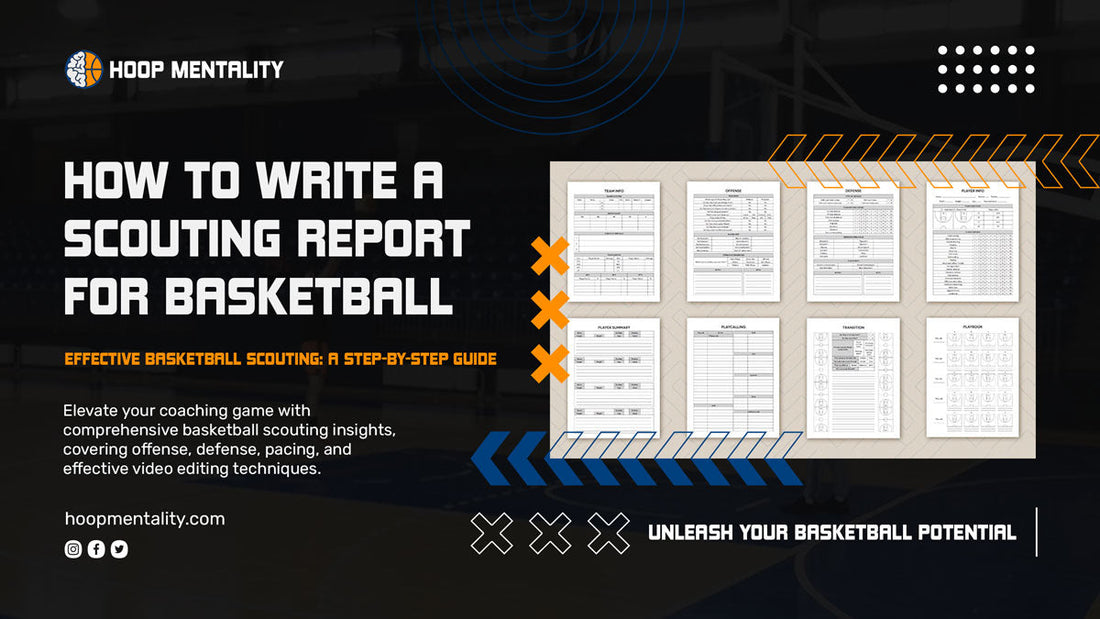Introduction: How To Write A Scouting Report For Basketball

If you're a young coach, assistant, or someone transitioning into the scouting role, understanding how to write an effective basketball scouting report is crucial. In today’s highly competitive environment, well-structured scouting reports are no longer a luxury — they are a necessity. They help coaches prepare smarter game plans, identify mismatches, and anticipate opponent strategies.
In this article, I’ll guide you through the core components of effective scouting — from analyzing offense and defense, to understanding tempo, video editing, and preparing reports your players will actually use. Whether you're coaching at the youth, high school, or professional level, mastering this process can help you win games.
To make your job easier, I’ll also share the tools I personally use — fully editable, printable, and ready-made scouting templates available through Hoop Mentality. These include the Basketball Scouting Report Template (Printable), Opponent Scouting Checklist For Coaches, Basketball Scouting Bundle, and even a Blank Basketball Court Diagram you can print and draw plays by hand. For coaches looking for the full system, the All-In-One Bundle is the most complete resource we offer.
Offense Scouting: Decoding Opponent Strategy

Understanding your opponent’s offensive identity is the first step. You’re not just watching for plays — you're looking for patterns, principles, and preferences.
1. Tempo & Tendencies: Are they a fast-paced team that thrives in transition, or do they prefer structured half-court sets? When do they look to push? What’s their shot clock usage like? Track this over multiple games.
2. Entries: How do they initiate their sets — through dribble entries, wing passes, high post touches? Recognizing this helps you disrupt their flow early.
3. Sets & Spacing: Identify their main actions — stagger screens, floppy, horns, flex, etc. Know what they run for key players and under what conditions (baseline out of bounds, after timeouts, etc.).
4. Scoring Intent: Who are they trying to score with? Are they playing through a post player, running shooters off screens, or isolating their guards?
5. Repetition & Predictability: Note which actions show up repeatedly and under what game flow — end of quarters, against man or zone, etc.
6. Weak Links: Which players struggle under pressure? Who hesitates to shoot? Can you help off anyone? These small details influence your matchups and help rotations.
Defense Scouting: Understanding Coverages and Pressure Points

Once you understand how they try to score, you must now prepare for how they defend. This is where you identify ways to attack.
1. Base Defense: Are they man-to-man, pack line, switching everything, or do they play zone? Do they adjust by matchup or stick to one identity?
2. Pick-and-Roll Coverage: This is critical. Do they go under on non-shooters? Hard hedge? Drop coverage? ICE on the side pick-and-roll? Adjust your spacing and angles accordingly. (For help on this, read our guide on Advanced Ball Screen Strategies For Coaches)
3. Help Side & Rotations: How do they tag rollers, rotate on drives, and recover on skips? Any slow or lazy help defenders?
4. Zone & Press: Do they press after made free throws? Switch to zone on dead balls? Knowing these triggers lets you prepare counters.
5. Matchup Weaknesses: Identify their worst defenders and how to isolate them — this is where mismatches win games.
Strategic Decisions: Game Planning From Data

After breaking down the opponent’s offense and defense, you must choose where to focus your adjustments. You can’t take away everything — so prioritize:
1. Target the Key Action: What one or two things do they rely on to score consistently? Build your game plan around disrupting those.
2. Take Calculated Risks: Can you switch everything? Can you go under on a poor shooter to clog the paint? These decisions create tactical advantages.
3. Know Your Own Team: Are your players disciplined enough to ICE or trap effectively? Can your bigs show and recover?
4. Practice Solutions: Don’t just put info on paper — simulate their actions in practice. Reps > Info.
Strategic Pacing: When to Slow Down or Speed Up

Tempo is part of the scouting puzzle. If they’re better in half court, push the pace. If they thrive in transition, slow it down. Recognize when to use press breaks, delay offenses, or tactical fouling to control rhythm.
Don’t forget to reference our guide: Transition Offense Against Any Defense
Video Editing: Preparing Clips For Your Team

Good clips > Long clips. Your job is to communicate what matters — not to overwhelm your team.
1. Watch 2-3 Games: Always use full games, not just highlights.
2. Note Key Actions: Timestamp everything — transition baskets, pick-and-rolls, inbound plays, etc.
3. Sort by Theme: Create folders or timelines for Offense, Defense, Actions, Players.
4. Keep it Tight: Trim to 30-second segments max. Include freeze frames, text labels, or arrows if possible.
Conclusion: Build Better Reports, Win More Games

Effective scouting is what separates reactive coaches from prepared ones. A clean report, strong video, clear plan, and confident players — that’s your edge.
If you're ready to simplify and upgrade your scouting system, check out:
- Basketball Scouting Report Template (Printable)
- Opponent Scouting Checklist For Coaches
- Basketball Scouting Bundle – includes everything listed above
- Blank Basketball Court Diagram – for drawing plays during prep
- All-In-One Bundle – the most complete solution for season planning
Good scouting wins close games. Plan smart. Prepare hard. Coach better.

